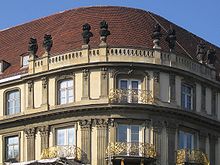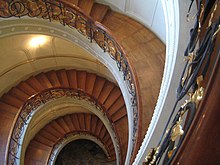Ephraim Palace
 Ephraim-Palais Museum, summer 2010 |
|
| Data | |
|---|---|
| place |
Berlin |
| Art |
historical Museum
|
| architect | Friedrich Wilhelm Diterichs |
| management | |
| Website | |
| ISIL | DE-MUS-813316 |
The Ephraim-Palais is a rococo building reconstructed in the 1980s on the edge of the Nikolaiviertel in Berlin 's Mitte district . It is a listed building and is considered one of the most beautiful historic town houses in the city. As the Museum Ephraim-Palais , it is now part of the Stadtmuseum Berlin Foundation .
Client
The history of the Ephraim-Palais is linked to the namesake Veitel Heine Ephraim . Its importance arises from the connection between the situation of the Jews in Prussia at the time of Frederick II and the constant financial needs of the king. The building was constructed from 1762 to 1769.
Ephraim was one of the king's privileged protective Jews . As a wealthy trader and banker, he had already lent money to the Crown Prince , later King Frederick II, and thereby secured his goodwill. He later financed a large part of Frederick's campaigns. On the orders of the king, he reduced the quality of the silver coins and took responsibility for them - also on royal orders. The citizens responded with mocking verses: "Outside silver, inside tin / outside Friedrich, inside Ephraim", these low-value coins were called Ephraimites . He acquired a large fortune as a leaseholder of coins, collector of war contributions in occupied territories, as a court jeweler and through other businesses. He invested part of the money in factories and factories, thereby promoting Berlin's economic development. In order to represent his position appropriately, he bought the town house of a Berlin family in 1762 and had it completely rebuilt.
building
The oldest pharmacy in Berlin once stood on the property at the corner of Poststrasse and Mühlendamm . Ephraim commissioned the architect Friedrich Wilhelm Diterichs to build a handsome city palace here. Diterichs had been the chief building director in Berlin since 1742 and had erected important buildings, including the Bethlehem Church and the Prinzessinnenpalais . Between 1762 and 1766 a four-storey building was built, the two wings of which meet at an obtuse angle.
The architect designed the difficult connection of the building parts as a rounded corner with a balcony in front of it, richly decorated with a filigree, gilded grille and with putti figures and supported by Tuscan columns that frame the main portal at ground level. These double columns continue in the vertical structure of the facade; a balustrade adorned with vases forms the top .
The characteristic motif of the rounded corner is recorded inside. There, the rooms of the side wings are accessed via an oval vestibule, behind which lies a bright, likewise oval staircase with spiraling steps. The elliptical shape can also be found in the ballroom on the main floor.
history
The builder Ephraim lived and worked in the palace himself. There was a silver refinery in the courtyard. The shops on the ground floor, which extended the stalls in the Mühlendamm Colonnades, were rented out. Ephraim died in 1775. The palace remained in family ownership until 1823.
The city of Berlin acquired the conveniently located house in 1843, and the city bailiff was opposite on Molkenmarkt. The magistrate housed police officers and the registration office here. In 1892–1895, the architect and city planning director Hermann Blankenstein expanded the attic. In 1888 the Mühlendamm was raised by 1.20 meters to widen the roadway. The ground floor shops were lost. This change in level also led to changes in the facade.
To replace the fixed Mühlendamm with a bridge, an even steeper ramp was necessary to cross the Spree in 1935. In connection with the plans of the National Socialists to create a Gauforum in front of the town hall and a representative access road, the Ephraimpalais was demolished. From then on, the property served as an access to a makeshift bridge that kept traffic during the construction work.
The facade and individual components were stored in what would later become West Berlin on a storage area in the Wedding district and survived the Second World War there . At times it was intended in West Berlin to rebuild the palace at a new location in Kreuzberger Lindenstrasse and to use it as a museum building for the planned Jewish department of the Berlin Museum. This plan could not be implemented because the construction documents were in East Berlin and the costs ( estimated at around 30 million marks around 1982 ) seemed too high.
When the construction of the Nikolaiviertel in East Berlin began in preparation for Berlin's 750th anniversary , the West Berlin House of Representatives decided in 1982 to make the remaining components available. In return, the GDR handed over, among other things, the archive of the Royal Porcelain Manufactory (KPM) to the western part of the city. A number of other cultural assets were exchanged at the time.
Under the direction of the architect Franz Klinger, the Ephraim-Palais was rebuilt about 12 meters north of the original location from 1985 to 1987 based on the original building and using the preserved façade parts . The original location was no longer available due to the widening of the Mühlendamm in the 1960s to a total of eight lanes.
The interior was given a design with simplified rococo ornamentation . One room on the first floor contained a copy of a ceiling designed by Andreas Schlüter from the Palais Wartenberg, which was demolished in 1889 .
After around four years of construction, the grand reopening of the Ephraim-Palais took place on May 19, 1987, now as part of the Märkisches Museum . After German reunification , it became part of the Stadtmuseum Berlin Foundation. On three floors, changing exhibitions are shown, which are intended to address Berliners and tourists first and are intended to be dedicated to the Berlin lifestyle and everyday Berlin issues such as sport, East and West Berlin, pleasure / celebrations, subcultures, living / living or work. Larger exhibitions were “West: Berlin. An island in search of the mainland ”,“ Dance on the volcano - Berlin in the twenties in the mirror of the arts ”and“ Berlin - city of women ”. The house also houses the city museum's graphic collection. This covers a period from the 16th century to the present day. 110,000 sheets result in a pictorial memory of Berlin, the Mark Brandenburg and Prussia.
See also
literature
- Rolf-Herbert Krüger: The Ephraim-Palais in Berlin - history and reconstruction. In: Miniatures on the history, culture and monument preservation of Berlin, No. 25. Kulturbund der DDR , Berlin 1987, ISSN 0233-0156
- Rolf-Herbert Krüger: The Ephraim-Palais in Berlin - A contribution to Prussian cultural history. Verlag für Bauwesen, Berlin 1990, 2nd edition, ISBN 3-345-00241-8 .
- Dagmar Claus: Poststrasse 16 / corner of Molkenmarkt . In: Berlin monthly magazine ( Luisenstädtischer Bildungsverein ) . Issue 2, 1996, ISSN 0944-5560 , p. 55-59 ( luise-berlin.de ).
Web links
- Ephraim Palace
- City Museum Berlin Foundation
- Kathrin Chod, Herbert Schwenk, Hainer Weisspflug: Ephraim-Palais . In: Hans-Jürgen Mende , Kurt Wernicke (ed.): Berliner Bezirkslexikon, Mitte . Luisenstadt educational association . tape 1 : A-N . Haude and Spener / Edition Luisenstadt, Berlin 2003, ISBN 3-89542-111-1 ( luise-berlin.de - as of October 7, 2009).
- Entry in the Berlin State Monument List with further information
- Berlin.de
- Graphic collection of the Stadtmuseum Berlin
Individual evidence
- ↑ Director and chief curator Paul Spies presents the future strategy for the Stadtmuseum Berlin. In: Stadtmuseum Berlin , press releases, July 16, 2016, accessed on December 21, 2017
- ^ Graphic Collection of the Stadtmuseum Berlin In: Stadtmuseum Berlin, Collections Berlin in der Kunst , accessed on December 21, 2017




